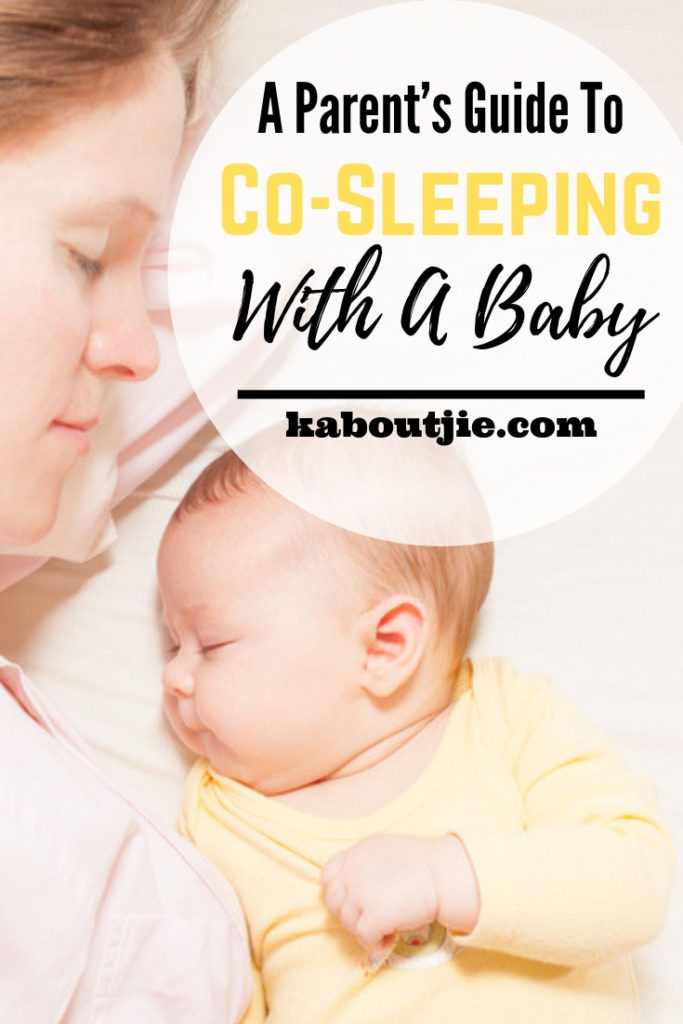Co-sleeping is a practice in a household with infants or babies. It doesn’t necessarily mean that babies and parents are sleeping in the same bed as there has been an opposing opinions in doing so. It essentially means you and your sleeping child can be in the same room and near each other.
Parents can monitor the infant who is sleeping and there is that confidence that the baby’s needs will be attended in a timely manner. While co-sleeping with your baby, you might want to get comfortable pillows just so in cases that you will be awake and just watching over your baby.

There are different types of co-sleeping a parent can practice:
Bed-sharing
The parent or both parents, especially breastfeeding mothers, sleep in the same bed with the child. While bed-sharing is deemed unsafe, risks can be avoided if a parent observes safe practices of bed-sharing:
- Premature or low birth-weight babies are vulnerable so should only be sleeping on a separate surface to reduce the risk of SIDS (Sudden Infant Death Syndrome).
- Avoid sharing a bed with an infant if you have consumed alcohol, sedative or even when you are overly tired. This will make you unfit to attend to your baby.
- Siblings should not share a bed with the infant. It should always be someone who can take full responsibility of the infant’s presence in bed.
- Do not swaddle the baby. The baby needs to move its arms or legs to alert the parent who gets too close, or to move covers from their face when overheating.
- Long hair should be tied up, so it doesn’t entangle around baby’s neck.
- Parents who may have a condition that prevents them from feeling how close their baby is in relation to their own body should let the baby sleep on a separate surface.
- Your bed and the wall or furniture should have no gap to avoid babies rolling over and being trapped.
- Do not have heavy, soft or loose bedding that may trap and suffocate the baby such as quilts, pillows, comforters or blankets.
- For non-breastfeeding mother, sleep in a face-height position with your baby.
- Adults should come to agreements that they both have equal accountability on the baby’s safety.
- Do not put a sleeping baby between two parents.
Sidecar arrangement
A securely attached crib is positioned next to the mother’s side of the bed. The side of the crib can be lowered or removed while the three remaining side remains intact.
Different beds, same room
A baby sleeps in a bassinet, cot, moses basket or crib in the same room with their parents within the desired distance.
Child welcome in parents’ room when needed
The child or baby has a room of its own but is welcome to the parents’ bedroom after a night walk.
Co-sleeping, in general, is associated with high-risk of SUDI or SIDS. Thus, necessary precautions that constitute to a safe sleeping environment needs to be taken regardless of which setup you follow.
Before you co-sleep:
- Make sure the baby sleeps on her back and not on her side nor her tummy.
- Do not put covers on baby’s head — no pillows or stuffed animals close to the baby’s face.
- The bed should be firm, and sheets are tightly placed.
- While swaddling soothes a baby, it reduces the baby’s arousal ability during sleep which is essential for their self-preservation instinct. It lets them wake up when any possible physical movement puts them at risk. A one-piece sleeper can be an alternative.
- Always check the room temperature. While it is nice to keep the baby warm, an unchecked thermostat may cause fuss and uneasiness in their sleep.
- Both parents should be a non-smoker. Smoke particles stick in your skin, clothes, and hair regardless if you have a ventilator. Third-hand smoking can cause serious health problem to a vulnerable child.

Both parent and child can enjoy the benefit of co-sleeping given the safety precautions are followed religiously. Aside from feeling safe and secure, co-sleeping can help:
- Boosts Development
Isolating the baby in a room doesn’t ignite its senses. Having movements, touches, heat, smell and sound around can help the baby be more responsive which is essential to its sensory development. - Improves Sleep Time
This can be for both mother and child. There will be no need for you to get up, walk the hallway to feed and comfort the baby. Breastfeeding will be a whole lot easier and lesser bedtime hassles. - Decrease in anxiety
Co-sleeping can give you the ability to have a visual of your child at any time. It reduces separation anxiety at night. - For working moms, co-sleeping can help make up for the times being away from their child.
- Less crying time at night
Keeping your baby in an arm’s length distance makes you detect baby’s needs immediately before they start crying. - Sealed attachment
Co-sleeping can help seal the emotional bond between parent and child. The assurance that they being cared for can help minimize their distress especially when the parent needs to leave. - Adequate milk supply
Since babies need to be fed frequently, a balance on their demand can help maintain adequate milk supply. - Better rest
The oxytocin released by a mother’s body can contribute to the quality of sleep a baby is getting. Since mother and baby have a deep physiological connection, both can have a better sleep knowing they are safe and secure. - Waking up to your baby’s beautiful smile.
If you are a new mom, things can get a bit overwhelming before it gets easier. Do not be frustrated if your baby can’t get a deep sleep like you wish the baby can have. Babies can’t get that kind of sleep immediately. The mother’s presence and the smell of her breast milk keep the baby in the light stage of sleep. This protects them from episodes of apnoea since they can easily be awakened.
Some risks come along with co-sleeping if done wrong and significant benefits to both parent and child if done right. Make sure to remember the tips and execute them properly as you start co-sleeping with your baby.
 Kaboutjie SA Mommy Blogs by Lynne Huysamen
Kaboutjie SA Mommy Blogs by Lynne Huysamen





We were too nervous to co-sleep. Our babies slept in their own cot in their own room from birth.
We co-slept until our kids wanted their own beds. It was quite tricky having 2 kids in the bed with us for so long – we had to make an interesting bed arrangement (king bed plus a single next to it) so we all had enough space. It is great that our kids now sleep (mostly) in their own rooms, it gives hubby and I a little more privacy, plus we have so much more space.
Thank you for the informative article. I never considered that it is actually dangerous to sleep with my hair loose until now.😲